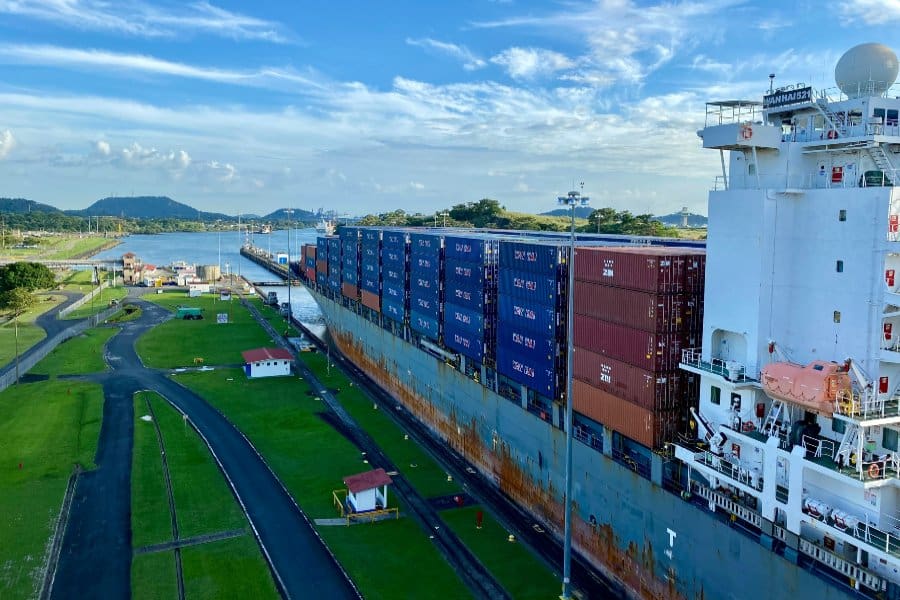The Panama Canal stands as an iconic testament to human ingenuity and strategic foresight, forever altering the course of global trade and geopolitics. Since its completion over a century ago, this engineering marvel has served as a vital artery connecting the Atlantic and Pacific Oceans, significantly impacting the economic, military, and geopolitical landscape of the United States. Its construction and subsequent control have facilitated the seamless movement of goods and bolstered America’s influence on the world stage. In this article, we delve into the myriad ways the Panama Canal has played a pivotal role in shaping the trajectory of U.S. interests, from enhancing trade routes to projecting military power, and examine its enduring significance in the modern era.
How did the Panama Canal help the US?
The Panama Canal profoundly benefited the United States in several key ways. Primarily, it revolutionized global trade by drastically reducing travel time and costs for ships traveling between the Atlantic and Pacific Oceans, thus facilitating the movement of goods and enhancing economic efficiency. Moreover, strategically, the canal bolstered U.S. military capabilities by providing a shortcut between the nation’s eastern and western coasts, enabling quicker deployment of naval assets and enhancing national defense. Additionally, the canal’s control solidified America’s geopolitical influence, as it asserted dominance over a critical maritime chokepoint, allowing the U.S. to safeguard its interests in the Western Hemisphere and beyond.
Historical Context: The Panama Canal’s Construction
The construction of the Panama Canal is a testament to human ambition, perseverance, and engineering prowess. Conceived initially as a shortcut between the Atlantic and Pacific Oceans, the idea dates back to the 16th century when Spanish conquistadors explored the narrow isthmus of Panama. However, it was in the late 19th century that serious attempts were made to realize this vision.
The French began the first significant effort in the 1880s under the leadership of Ferdinand de Lesseps, the mastermind behind the Suez Canal. However, their ambitious attempt was plagued by technical challenges, financial mismanagement, and devastating health issues, particularly malaria and yellow fever, which took the lives of thousands of workers.
The failure of the French endeavor didn’t deter the United States from pursuing the project. In the early 20th century, under President Theodore Roosevelt’s administration, the U.S. took up the challenge. The Panama Canal became a symbol of American industrial might and global ambition. The canal’s construction was marked by immense challenges, including the need to carve through rugged terrain, deal with landslides, and overcome deadly diseases like malaria and yellow fever.
Despite these obstacles, the U.S. successfully completed the construction of the Panama Canal in 1914, marking a monumental achievement in engineering history. The canal’s completion revolutionized global maritime trade and solidified America’s position as a dominant player on the world stage. Today, the Panama Canal remains a vital artery of international commerce, connecting distant corners of the globe and serving as a testament to human innovation and perseverance.
Economic Benefits of Panama Cana
The Panama Canal has conferred significant economic benefits to the United States since its completion in 1914, fundamentally altering global trade routes and bolstering the U.S. economy in several pivotal ways. Here is a detailed exploration of these benefits:
Reduction in Shipping Time and Costs:
The Panama Canal drastically reduced the distance ships traveled between the Atlantic and Pacific Oceans. Before the canal, vessels had to undertake the lengthy and challenging journey around South America’s Cape Horn, significantly adding to travel time and operational costs. By providing a shortcut, the canal allowed ships to save thousands of miles on their voyages, translating into lower fuel costs, reduced wear and tear on vessels, and faster delivery times for goods. This efficiency boost has been particularly beneficial for transporting bulk goods and commodities, which form a large part of international trade.
Stimulus to Trade and Commerce:
The Panama Canal has directly stimulated trade and commerce globally and for the U.S. economy by facilitating quicker and more cost-effective shipping routes. It has enabled the faster and more economical transport of American exports and imports, ranging from agricultural products to manufactured goods, enhancing the competitiveness of U.S. products in global markets. This increased trade activity has contributed to economic growth, job creation, and the development of various sectors within the U.S. economy.
Boost to the Maritime Industry:
The Panama Canal’s existence has significantly benefited the U.S. maritime industry, including shipping companies, shipbuilders, and ports. The canal’s operational requirements have driven demand for specialized vessels designed to navigate its locks, such as Panamax and Neo-Panamax ships. This has spurred innovation and growth in shipbuilding and related industries. Moreover, U.S. ports on both coasts have expanded and upgraded their facilities to accommodate the larger ships and increased trade flows resulting from the canal, leading to economic development in these regions.
Strategic Global Position:
The canal has enhanced the strategic position of the U.S. in global trade networks. The U.S. enjoyed enhanced economic and geopolitical leverage by controlling one of the world’s most vital shipping lanes until the end of the 20th century. Even after transferring control of the canal to Panama, the U.S. continues to benefit from the preferential treatment regarding usage fees and access, ensuring American commercial interests are well-served.
Impact on Global Supply Chains:
The Panama Canal has critically shaped modern global supply chains. It has enabled more efficient and flexible routing options for international trade, contributing to developing just-in-time delivery systems and globalized production models. The canal’s ability to accommodate larger vessels after its expansion has further solidified its importance in international logistics, facilitating the movement of larger volumes of goods and lowering transportation costs per unit.
Strategic Importance Of The Canal During Times Of War And Peace
The strategic importance of the Panama Canal, both during times of war and peace, cannot be overstated. Since its completion in 1914, the canal has served as a pivotal asset for military and strategic operations and has significantly impacted global trade and economics. Here’s a detailed exploration of its strategic value:
Military Mobility and Response Time: During times of conflict, the Panama Canal has offered the United States unparalleled military advantages by drastically reducing the time required for naval vessels to move between the Atlantic and Pacific Oceans. Before the canal, ships had to navigate the lengthy and challenging route around South America’s Cape Horn, which could take months. The canal’s ability to shorten this trip to a matter of days has been a crucial factor in the rapid deployment of naval forces, allowing the U.S. to project power more effectively and respond quickly to emerging threats around the globe.
Control of a Strategic Chokepoint: The Panama Canal represents one of the world’s key strategic chokepoints, a narrow passage whose control can influence global maritime trade and military movement. During both World Wars, the canal’s operational integrity and security were paramount for the Allies, facilitating the efficient movement of troops, supplies, and equipment. Control over such a vital artery has allowed the U.S. to exert considerable influence over maritime trade routes, underscoring the canal’s importance in global strategic calculations.
Economic Warfare: The canal’s role extends into economic warfare, where controlling critical infrastructure can significantly impact an adversary’s economy and warfighting capabilities. By regulating access to the canal, the U.S. can potentially disrupt the economic activities of hostile states, limiting their ability to import essential goods or export products to fund their military operations. This aspect of control has made the canal a focal point in U.S. defense and foreign policy, particularly in safeguarding its interests and maintaining global stability.
Peace-Time Vigilance and Global Influence: In peacetime, the strategic importance of the Panama Canal shifts towards ensuring the security and smooth operation of this global trade conduit. Even after the transfer of canal control to Panama in 1999, the U.S. military’s presence in the region underscores the ongoing strategic value placed on the canal. The U.S. continues to work closely with Panama to counter threats such as drug trafficking and terrorism, ensuring the canal remains a safe and open passage for international commerce. This cooperation enhances the U.S.’s influence in Latin America and demonstrates its commitment to global security.
The Panama Canal Today
The Panama Canal today stands as a testament to human ingenuity and a pivotal artery in the global trade network, significantly evolving from its inception over a century ago. Its continued relevance and the recent expansion project reflect the canal’s adaptation to the changing dynamics of international commerce and maritime transportation. Here’s an overview of the Panama Canal in the contemporary context:
- Expanded Capacity and Modernization: The most significant recent development is completing the Panama Canal Expansion Project, officially inaugurated on June 26, 2016. This expansion added a new traffic lane by constructing a third set of locks, the Cocoli Locks on the Pacific side and the Agua Clara Locks on the Atlantic side. This project doubled the canal’s capacity by allowing larger vessels, known as Neo-Panamax ships, to traverse the canal. These ships can carry up to three times the cargo of the older Panamax vessels, significantly impacting global shipping patterns and economies, including the U.S., by reducing costs and improving efficiency for long-haul shipping.
- Economic Impact: The expanded canal enhances its role in global trade, especially benefiting the liquefied natural gas (LNG) market, container ships, and bulk carriers. The canal has become increasingly vital for the energy sector by accommodating larger vessels and enabling more efficient routes for LNG shipments from the U.S. Gulf Coast to Asian markets. This capability aligns with global energy consumption pattern shifts and the U.S.’s growing role as an energy exporter. The canal’s expansion has also prompted ports worldwide, particularly along the U.S. East Coast, to undertake significant dredging and infrastructure upgrades to handle the larger Neo-Panamax vessels, driving economic activity and job creation in port cities.
- Strategic Importance: The Panama Canal is a critical maritime route underpinning U.S. military and economic interests. While the U.S. no longer controls the canal, its importance to American and global maritime strategy remains undiminished. The canal facilitates the rapid deployment of U.S. naval assets between oceans, supporting the U.S.’s ability to project power globally and respond to threats. Furthermore, the U.S. maintains a strong relationship with Panama to ensure the canal’s security and operational integrity, reflecting its ongoing strategic value.
Conclusion
The Panama Canal’s enduring legacy and continued evolution underscore its profound impact on global trade, military strategy, and international relations. Since its inception over a century ago, the canal has facilitated the dramatic reshaping of maritime routes, significantly reducing the time and cost associated with global shipping. Its strategic importance has been consistently demonstrated, serving as a crucial asset in war and peace. It enhances the United States’ ability to project power globally and maintain a pivotal role in international commerce. The economic benefits derived from the canal have been substantial, driving growth in trade, bolstering the maritime industry, and fostering economic development both within the United States and worldwide. The canal’s expansion project, completed in 2016, marked a significant milestone in its history, allowing it to accommodate modern shipping demands and ensure its relevance in the age of globalized trade.










